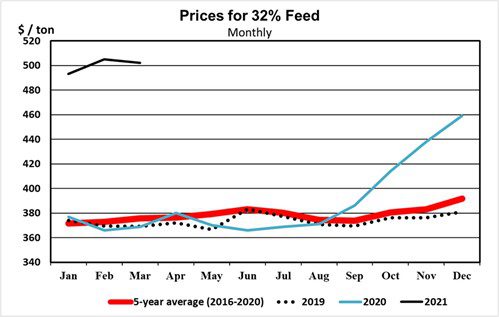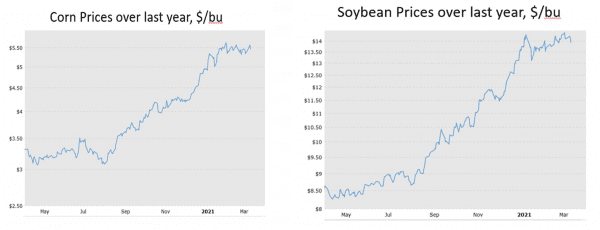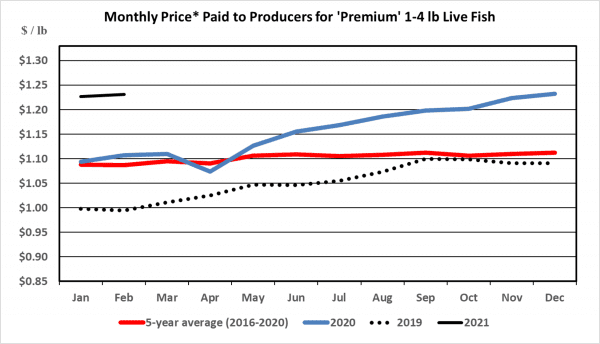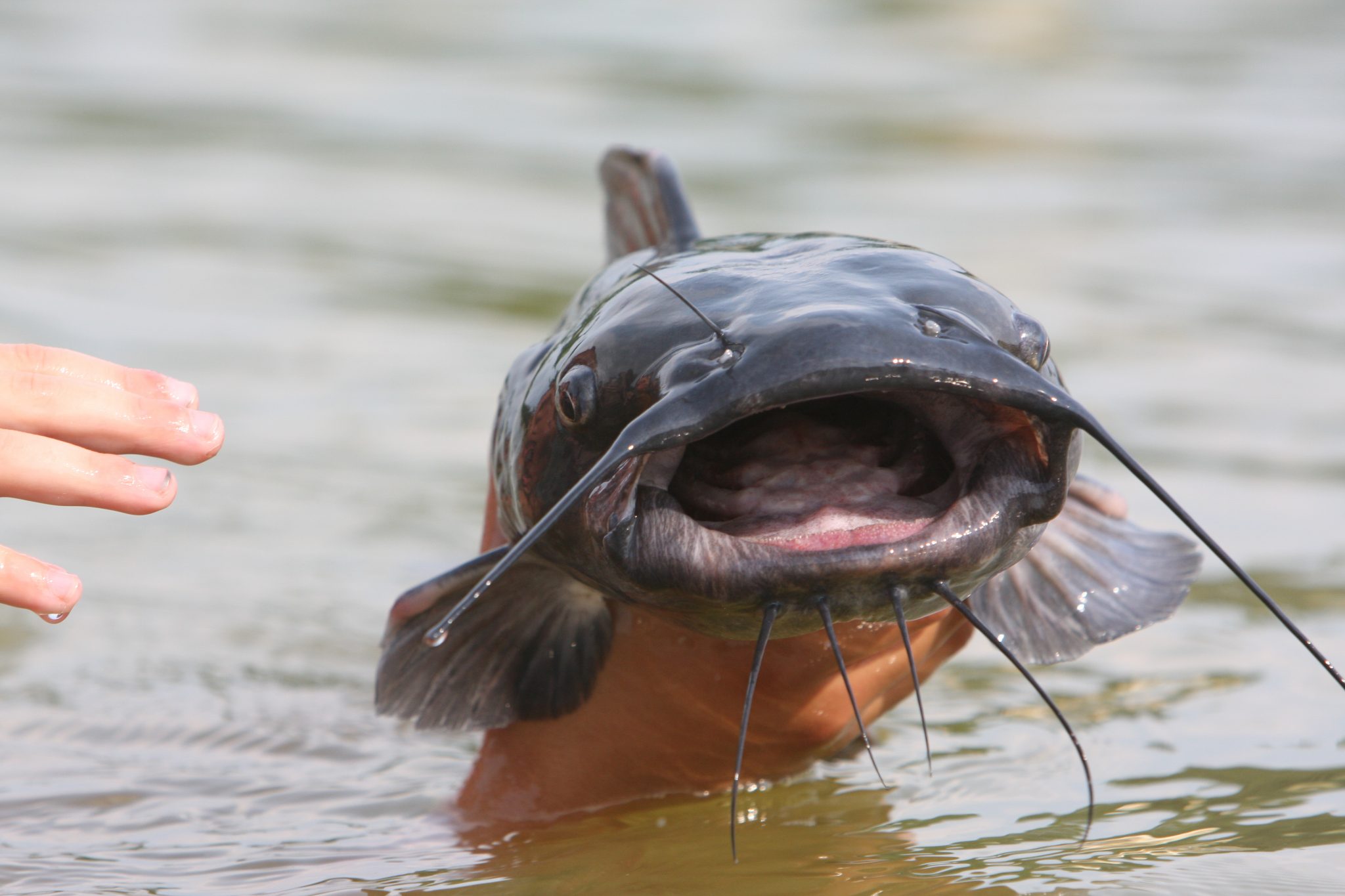Fish & Water

In the catfish industry, feed prices can be affected greatly by fluctuating prices in the corn and soybean markets. Thirty-two percent catfish feed contains 30 to 44 percent soybean meal, 15 to 20 percent corn grain, and 0 to 20 percent corn gluten feed. As corn and soybean prices rise, catfish fish feed prices do as well.
2020 Markets
In 2020, catfish feed prices were stable January through August but increased 18 percent through the last four months of the year (Figure 1). A decreased supply in corn and soybean production in the United States led to an increase in corn, soybean, and soybean meal prices. This decrease in crop supplies was caused by several items, including trade, drought, storm damage, and yield decreases. The result was corn and soybean prices going up 70 and 65 percent, respectively (Figure 2). Fortunately for catfish producers, the price they received for the catfish sold to processors also increased in 2020, being over $1.09 per pound all year with a high price of $1.23 per pound in December 2020 (Figure 3).

Figure 1. Catfish feed prices for 32 percent protein feed in 2019, 2020, and 2021 as well as the five-year average.

Figure 2. 2020 -2021 corn (+78 percent since July 2020) and soybean (+66 percent since July 2020) prices. Source: Macrotrends

Figure 3. Premium sized catfish (1 to 4 pounds) price to producer for 2019, 2020, 2021, and the five-year average.
Overcoming High Feed Prices
Watch Future Markets
Catfish producers should always keep an eye on the corn and soybean futures market prices. Future markets provide one source of price predictions. The primary crop ingredients in catfish feed are soybean meal and corn, at about 50 and 37 percent, respectively. A producer can check future markets through the Chicago Board of Trade. There, they can see futures contracts on corn and soy traders who are using all available information to ultimately determine future prices. To check on commodity future contract prices, visit the CME Group website and search for corn quotes, soybean quotes, or soybean meal quotes.
Future commodity prices are a pretty good summary of factors likely to influence market prices. When comparing current commodity prices with future contract prices six to eight months later in the year, future prices provide an idea of which way traders currently expect the commodity’s price will go. As show in Table 1, the future prices for each commodity are slowly decreasing over the next two to eight months. However, conditions change quickly, and as new information about crop production becomes available, these future prices are adjusted accordingly.
Table 1. Chicago Board of Trade Commodity Grain Actual Price to Future Price (CME)
2 Prices measured in $/ton
| Date | Price | |
|---|---|---|
| Corn1 | ||
| Actual | March 19, 2021 | $5.53 |
| Future | May 2021 | $5.51 |
| Future | July 2021 | $5.33 |
| Future | September 2021 | $4.86 |
| Future | December 2021 | $4.68 |
| Soybean1 | ||
| Actual | March 19, 2021 | $14.08 |
| Future | May 2021 | $14.05 |
| Future | July 2021 | $13.92 |
| Future | August 2021 | $13.48 |
| Future | September 2021 | $12.61 |
| Future | November 2021 | $12.13 |
| Soybean Meal2 | ||
| Actual | March 19, 2021 | $405.3 |
| Future | May 2021 | $404.2 |
| Future | July 2021 | $403.8 |
| Future | August 2021 | $396.6 |
| Future | September 2021 | $386.4 |
| Future | October 2021 | $373.8 |
| Future | December 2021 | $371.2 |
Booking Feed Prices
Booking catfish feed prices is not an all-or-nothing proposition. Given the potential for significant price volatility, producers might consider booking a portion of their feed needs. It may be good for producers to book some of their feed early and see how the prices are in once to two months. At that time they can reconsider if additional feed should be booked or not. However, producers should check with their feed supplier to learn more about their booking requirements, such as minimum acceptable amounts, times for booking and delivery, payment method, etc.
Remember, it is not necessary and probably not advisable in most circumstances to book 100 percent of anticipated feed needs. However, lining up some portion of those needs may have some advantages. If feed prices go up significantly, at least a portion of that increased feed price has been avoided. If feed prices decline, the producer can take advantage of that decline on the portion of feed purchases not made in advance. Also, having some feed booked may help a producer narrow down expected production expenditures and per-unit costs of production. This can help develop financial plans for the coming year and, if pre-paid, may help reduce taxes.
Alternative Feeding Strategies
Producers can consider alternative feeding strategies for unfavorable economic conditions. One of these strategies is feeding every other day instead of every day. Feeding strategies on farms are sensitive to the levels of available capital, feed price, and fish price. Under higher feed prices or tighter credit, every other day feeding may become necessary. However, at current feed and fish prices (April 2021), feeding should be every day. Every other day feeding is optimal only when feed prices are extremely high. Feeding every third day is not an optimal feeding strategy. Be aware that switching to feeding every other day will decrease total fish produced. Many farmers will disagree with this strategy as they know more catfish pounds to sell is better than fewer pounds.
Producers can also try to reduce their cost of feeding by feeding a 28 percent protein diet.
Ganesh Kumar at the National Warmwater Aquaculture Center in Stoneville, Mississippi offers the following additional tips for alternative feeding strategies:
- Monitor feed budgets and talk with lenders.
- Reduce the need for feeding by stocking less in the 2021-2022 growing seasons.
- Stocking relatively larger fingerlings will provide a greater head start in production.
- Prioritize and feed ponds that have fish approaching market size.
- Feeding every day is the best strategy for production. However, every other day feeding becomes optimal when feed prices are approaching $500 per ton.
Higher Prices Offsetting Costs
Currently, the bright spot for producers is that catfish prices are high now (Figure 3). The question is whether the higher fish prices will offset the higher feed costs. Producers can do a quick estimate to see whether they are making or losing money this year.
- Estimate feed costs by multiplying the expected feed quantity used by the expected higher feed price.
- Multiply the estimated feed costs by two, as feed is approximately 50 percent of total operating costs.
- Subtract the feed costs, and any other costs, from the expected sales revenue to calculate cash profit. Sales revenue is calculated by multiplying the quantity of fish expected to sell by the expected fish price.
There are a lot of unknowns here, but substituting in several feed/fish quantities and several expected fish/feed prices will give producers a range of returns that can inform them about their chances for operational success.
Conclusions
The decision of whether or not to contract either input purchases or output sales can be a difficult one because there are seldom any right or wrong answers (without the benefit of hindsight, that is). Each producer must make an individual decision based on several factors. Perhaps the most important thing to consider is an individual’s willingness and ability to stand the existing price risk. In this decision, it is important for the producer to determine whether or not the potential exists for a loss that would jeopardize the financial stability or survivability of the operation. If so, some type of contracting or forward purchase or sale would be an effective means of reducing that risk to an acceptable level.

